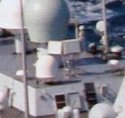williamhou
Junior Member
Posted by Icloo at the PDF. One of the two original 054 undergoing an MLU refit.
View attachment 52978
In my mind they are still new. But 14 years have past
Posted by Icloo at the PDF. One of the two original 054 undergoing an MLU refit.
View attachment 52978
The number of type 054B will probably double that of type 054A, in this hostile environment.





I really have grave doubts on this. You can check around for sources and the HQ-9, base version, comes already to around 6.8 meters (some say 7 meters.) This does not leave you much room for a cold launched system, but we are absolutely sure these missiles are launched via cold launched method and there are plenty of photographs of this already. The difference of 6.8 meters to 7 meters is just too small for a gas bottle to deal with the weight of an HQ-9, which is around 1300kg.
For a cold launch, you would need a large compressed gas bottle underneath the missile, which is used to pop the missile out of the tube. On a dedicated cold launch system ala RIF-M or the revolver style on the 052C, the gas bottle can be underneath the VLS tube.
But on a CCL, this cold launched system has to be packed within and below the canister itself. Remember the tube has the option for hot launched missile and in which case, the hot launched missile would not have a gas battle within the canister and would be left open on the bottom to channel the exhaust gases out.

This is going back a little while, however this photo was brought to my attention just today, which was probably the basis for why I believed the 7m UVLS was capable of accommodating HHQ-9 back during this discussion.
In this image HQ-9 has a length of some 6.5m at most, which I believed would've been sufficient to accommodate a cold launch mechanism. The 6.8m count was likely from old brochures of FT-2000.


Two problems. The cold launch bottle of the S-300, in which the HQ-9 system maybe copied from, is at least a meter. The ship VLS might possibly have a higher clear requirement than the land based VLS in case of a launch failure but who knows? Partly because it is already a proven system, the naval VLS may still be using the exact part used for the land based HQ-9 which in turn may just be a direct copy of the system used on the S-300 which is also like the one you see here on the bottom. Look at the 9M96 missiles here and despite the missiles are much smaller, they still use the same bottle from the S-300 because well, its already available and proven with countless firings, with no need for reinvention.
View attachment 53106
The second is that the VLS must have substantial growth overhead for future missiles, and that includes SAMs. The above may just be the base version of the HQ-9, but what about HQ-9B and future variants? There is a size growth between the 5V55 and the 48N6E missiles for the S-300. The most common way for a missile to extend its range is length growth. See the various members of the 9M96 missile family from the shorter ranged 9M96 to the long range 9M96E2.
Even with hot launched missiles, you still need significant clearance. The Strike version of the MK. 41 was intended to launch the Tomahawk missile. The length of the VLS is 6.8 meters long. The length of the Tomahawk, including booster, is 6.25m. The Tactical version of the Mk. 41 was created to launch the SM-3 and SM-6 missiles. The length of the Tactical version is 7.7m. The SM-6 is 6.6 meters long and the SM-3 is 6.55 meters long. And these are for hot launched missiles. The SCALP naval missile for the A70 Sylver is 6.5 meters long, and the A70 is 7 meters. That's about right for a .5 meters clearance but this is also a hot launch system.
I absolutely expect longer range HQ-9 variants to be developed, through two major directions:
1: enhancement of propellant, guidance, and materials using the existing form factor
2: the above + lengthening of the missile either by physically increasing the length of the existing missile or adding a booster to it.
Option 1 would be for the 7m VLS (continuing the LR SAM pathway) while option 2 would be for the 9m VLS (and introduce a VLR SAM capability to the Navy).
Remember, my previous suggestion was that 054A should be able to fire HHQ-9 sized LR SAMs in its VLS.
I'm not sure if those numbers are relevant unless we know if the missile dimensions those VLS cells accommodate is a reflection of the maximum length of the missile they are able to hold or not.

I recently skimmed through the vid of the PLA 90th anniversary parade, and the SAM with small circular launch tubes was called HQ-22.Left is an S-400 battery.
Middle is likely the HQ-9 battery.
Right is likely an HQ-16 battery.
